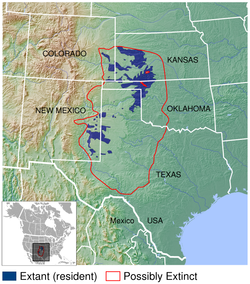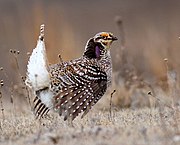Tympanuchus
Genus of birds From Wikipedia, the free encyclopedia
Tympanuchus is a small genus of birds in the grouse family. They are commonly referred to as prairie-chickens.
| Tympanuchus | |
|---|---|
 | |
| Male lesser prairie chicken (T. pallidicinctus) | |
| Scientific classification | |
| Domain: | Eukaryota |
| Kingdom: | Animalia |
| Phylum: | Chordata |
| Class: | Aves |
| Order: | Galliformes |
| Family: | Phasianidae |
| Tribe: | Tetraonini |
| Genus: | Tympanuchus Gloger, 1841 |
| Type species | |
| Tetrao cupido Linnaeus, 1758 | |
| Species | |
|
Tympanuchus cupido | |
| Synonyms | |
|
Pedioecetes | |
Taxonomy
Summarize
Perspective
The genus Tympanuchus was introduced in 1841 by the German zoologist Constantin Wilhelm Lambert Gloger for the greater prairie chicken.[1][2] The name combines the Ancient Greek tumpanon meaning "kettle-drum" with ēkheō meaning "to sound".[3]
The genus contains three species:[4]
| Common name | Scientific name and subspecies | Range | Size and ecology | IUCN status and estimated population |
|---|---|---|---|---|
| Sharp-tailed grouse | Tympanuchus phasianellus (Linnaeus, 1758) Seven subspecies
|
north to Alaska, south to California and New Mexico, and east to Quebec, Canada |
Size: Habitat: Diet: |
LC
|
| Greater prairie-chicken | Tympanuchus cupido (Linnaeus, 1758) Three subspecies
|
Central U.S., formerly to the Atlantic coast |
Size: Habitat: Diet: |
NT
|
| Lesser prairie-chicken | Tympanuchus pallidicinctus (Ridgway, 1873) |
western Oklahoma, the Texas Panhandle including the Llano Estacado, eastern New Mexico, and southeastern Colorado. |
Size: Habitat: Diet: |
VU
|
All three are among the smaller grouse, from 40 to 43 cm (16 to 17 in) in length. They are found in North America in different types of prairie. In courtship display on leks, males make hooting sounds and dance with the head extended straight forward, the tail up, and colorful neck sacks inflated (shown in the photograph at upper right). Tympanuchus comes from Ancient Greek roots and means "holding a drum"; it refers to the membranous neck sacks and the drum-like call of the greater prairie chicken.
The two prairie chickens are particularly closely related and look extremely similar. But their taxonomy and the evolutionary relationships of the Tympanuchus is yet to be discovered. There is still unknown information about these genera. But one thing we do know is that Tympanuchus are polyphyletic. They have a strong sexual selection (Galla, 2013).
They are commonly seen in the North American Prairies (Galla, 2013).
The extinct heath hen of the American East Coast, usually considered a subspecies of the greater prairie chicken, has been considered a separate species.
Uses
An Englishman visiting the United States in the 1850s reported that prairie hens taste "like pheasants in flavour, but the flesh is the colour of grouse."[5]
References
Wikiwand - on
Seamless Wikipedia browsing. On steroids.


